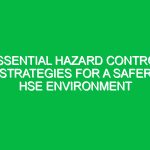Introduction
In today’s fast-paced work environments, the Safety and well-being of employees are paramount. Hazard Prevention and control are critical components in the Health, Safety, and Environment (HSE) domain, focusing on identifying, assessing, and mitigating risks to ensure a safe workplace. Understanding how to effectively manage Hazards can significantly reduce incidents, protect employees, and promote environmental Sustainability. This guide delves deep into the intricacies of Hazard Prevention and control, providing actionable insights and real-life examples to enhance your organization’s Safety protocols.
Understanding Hazard Prevention and Control
Hazard prevention and control should contain both proactive measures to eliminate Hazards before they cause harm and reactive strategies to respond to incidents when they occur. In the HSE context, this dual approach ensures that organizations are not only prepared for potential risks but also capable of swiftly addressing any issues that arise.
The Importance of Hazard Identification
The first step in effective hazard prevention is identifying potential hazards in the workplace. Hazards can be classified into several categories, including:
- Physical Hazards: These include machinery, noise, and environmental factors such as extreme temperatures.
- Chemical Hazards: Exposure to harmful substances, such as solvents, gases, and dust, falls under this category.
- Biosafety Hazards: These involve exposure to biological agents, including bacteria and viruses.
- Ergonomic Hazards: Poor workstation design and repetitive motion can lead to musculoskeletal disorders.
Recognizing these hazards requires thorough inspections, employee feedback, and a proactive safety culture. Regular Training and workshops can help staff identify hazards in their specific roles.
Risk Assessment: Evaluating Potential Impact
Once hazards are identified, the next step is conducting a risk assessment. This process involves analyzing the likelihood of an incident occurring and the severity of its consequences.
A simple framework for conducting risk assessments includes:
- Identify Hazards: Catalog all potential hazards in the workplace.
- Evaluate Risks: Determine the likelihood and impact of each hazard.
- Prioritize Risks: Rank hazards according to their potential impact on health and safety.
- Implement Controls: Develop strategies to mitigate identified risks.
For example, a manufacturing facility may identify a risk of machinery entrapment. By evaluating this risk, the facility can implement lockout/tagout Procedures to ensure equipment is properly shut down during Maintenance.
Implementing Control Measures
Control measures are essential in reducing the risks associated with identified hazards. These measures can be categorized into three main types:
- Engineering Controls: These involve redesigning equipment or processes to reduce exposure, such as installing guards on machines.
- Administrative Controls: These include policies and procedures that dictate safe work practices, such as shift rotations to minimize fatigue.
- Personal Protective Equipment (PPE): Equip employees with appropriate gear, like helmets, gloves, and goggles, to protect against specific hazards.
The hierarchy of controls emphasizes that organizations should prioritize engineering controls over administrative controls, and administrative controls over PPE. For instance, if a chemical spill is a risk, engineering controls like containment systems should be prioritized over simply providing PPE.
Ongoing Training and Communication
Effective hazard prevention and control should contain both training and communication strategies. Regular training sessions ensure that employees are well-versed in safety protocols and can identify hazards promptly. Moreover, fostering an open communication environment encourages staff to report hazards or unsafe conditions without fear of reprisal.
For instance, at a construction site, daily briefings can help workers discuss potential hazards they may encounter that day, ensuring everyone is prepared and informed.
Monitoring and Review: Continuous Improvement
The work environment is dynamic, and hazards can evolve. Therefore, continuous monitoring and review of safety practices are necessary. Implementing regular audits can help identify new hazards or failures in the existing Control Measures.
An example of this is a hospital that regularly assesses its infection control practices. By reviewing data on infection rates and employee feedback, the hospital can adjust protocols to mitigate new risks.
Regulations and Standards Governing HSE
In the realm of HSE, several Regulations and standards govern hazard prevention and control. Understanding these legal frameworks is vital for compliance and for fostering a culture of safety.
Occupational Safety and Health Administration (OSHA)
In the United States, osha sets forth regulations that require employers to provide a safe working environment. This includes the obligation to conduct hazard assessments, implement control measures, and provide training. Non-compliance can result in significant penalties and increased risk to employees.
International Organization for Standardization (ISO) Standards
ISO standards, such as ISO 45001, provide frameworks for Occupational Health and safety management systems. These standards guide organizations in establishing effective hazard prevention and control measures, offering a structured approach to risk management.
Environmental Protection Agency (EPA) Regulations
The EPA oversees regulations related to environmental hazards. Organizations must comply with these regulations to prevent pollution and manage hazardous waste effectively. Failure to adhere to these regulations can have severe consequences, including fines and environmental damage.
Conclusion
Hazard prevention and control should contain both proactive and reactive strategies, ensuring that organizations not only prepare for potential risks but also respond effectively when incidents occur. By understanding hazard identification, conducting thorough risk assessments, implementing control measures, and fostering an ongoing culture of training and communication, businesses can significantly enhance their safety protocols.
The importance of compliance with relevant regulations cannot be overstated. Organizations that prioritize hazard prevention not only protect their employees and the environment but also cultivate a reputation for responsibility and care.
In conclusion, embracing a comprehensive approach to hazard prevention and control is essential for promoting health, safety, and environmental sustainability. By committing to continuous improvement and a proactive safety culture, organizations can create a safer workplace for everyone involved.


